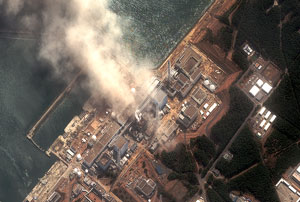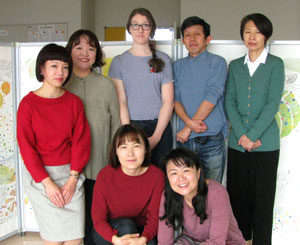Nov. 16, 2018 Research Highlight Biology
Cesium inhibits plant growth mainly by stifling potassium uptake
Cesium actively blocks the uptake of potassium by plants, starving them of the essential nutrient
 Figure 1: The nuclear disaster at Fukushima nuclear power plant resulted in vast areas of land being contaminated with radiocesium and other radioisotopes. Cesium-tolerant plants could be used as part of efforts to remediate such areas. © DIGITAL GLOBE/SCIENCE PHOTO LIBRARY
Figure 1: The nuclear disaster at Fukushima nuclear power plant resulted in vast areas of land being contaminated with radiocesium and other radioisotopes. Cesium-tolerant plants could be used as part of efforts to remediate such areas. © DIGITAL GLOBE/SCIENCE PHOTO LIBRARY
Cesium in the soil disrupts plant growth mainly through restricting the ability of plants to take up potassium—a vital nutrient—RIKEN scientists have discovered1. This finding will inform strategies to clean up cesium-contaminated soil and to protect plants from the harmful effects of contamination.
Radioactive cesium often contaminates land after nuclear disasters such as the one at the Fukushima Daiichi Nuclear Power Plant in 2011. Since plants readily take up cesium from contaminated soil, cesium-tolerant plants could be used to clean up contaminated regions. But producing such plants first requires understanding how cesium affects normal plants.
Part of the reason why cesium is bad for plants is because it is chemically similar to potassium, so that plants growing in cesium-contaminated soils can become deficient in potassium. But plant scientists have long suspected that cesium does more than just starve plants of potassium through competing with it—cesium also actively interferes with biological processes involving potassium.
Now, Ryoung Shin and Eri Adams at the RIKEN Center for Sustainable Resource Science and their co-workers have found that cesium blocks the uptake of potassium by the roots.
 Ryoung Shin (second on the left) and Eri Adams (far left), with other members of their group, have shown that cesium inhibits plant growth mainly by blocking the uptake of potassium. © 2018 RIKEN
Ryoung Shin (second on the left) and Eri Adams (far left), with other members of their group, have shown that cesium inhibits plant growth mainly by blocking the uptake of potassium. © 2018 RIKEN
The team tweaked the genome of the model plant Arabidopsis to disrupt the functioning of two key proteins, AKT1 and HAK5, which transport potassium across cell membranes. They found that plants lacking the AKT1 channel were highly sensitive to cesium and that their growth was severely stunted compared to that of control plants with fully functioning transporters. For example, the roots of AKT1 channels treated with cesium were about half as long as those of control plants when potassium was abundant.
When cesium was absent, the mutant plants accumulated only a third of the potassium of the control plants and suffered further potassium reductions when treated with cesium. In contrast, plants lacking the HAK5 transporter accumulated potassium and grew as well as control plants.
These results indicate that the AKT1 potassium channel is indispensable for the healthy growth of plants in the presence of cesium. The functions of other potassium transporters such as HAK5 seem to be redundant or are compensated when cesium is present, but the same is not true of AKT1—the absence of a single component of the AKT1 potassium channel leads to a hypersensitive response to cesium.
“These findings confirm that cesium-induced growth inhibition in plants occurs primarily through reduction of potassium accumulation and that this reduction happens because cesium blocks potassium influx through a major potassium channel,” says Adams. “Our findings will help scientists understand how to use plants to clean up radiocesium-contaminated lands.”
Related contents
- Protecting crops from radiation-contaminated soil
- Stress-relief strategies in plants
- Nature’s genius aids sustainability science
References
- 1. Adams, E., Miyazaki, T., Saito, S., Uozumi, N. & Shin, R. Cesium inhibits plant growth primarily through reduction of potassium influx and accumulation in Arabidopsis. Plant and Cell Physiology pcy188 (2018). doi: 10.1093/pcp/pcy188
